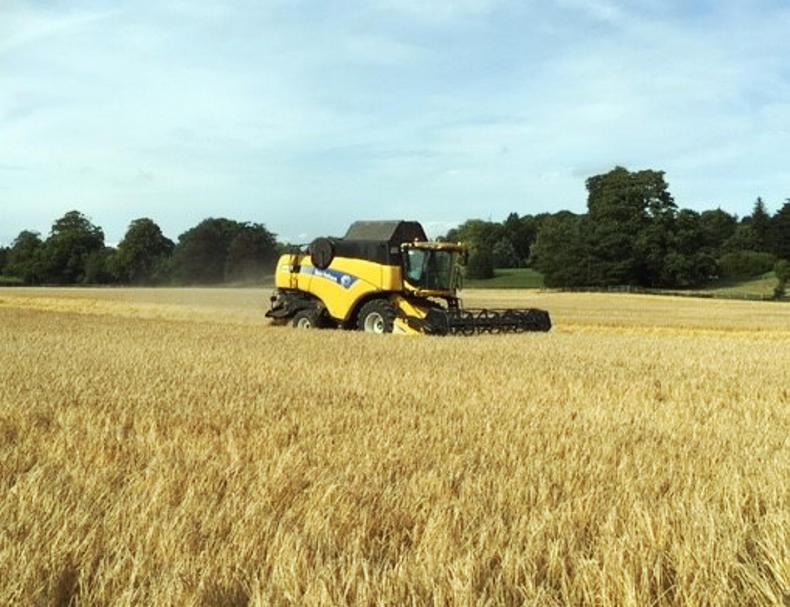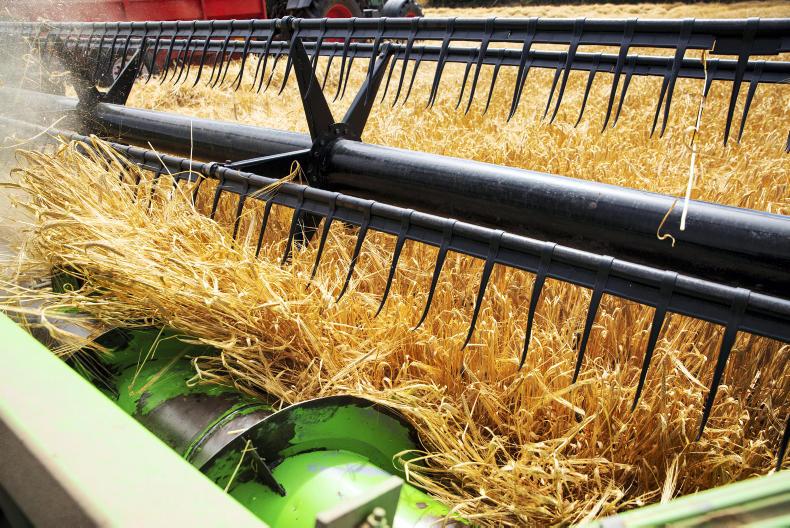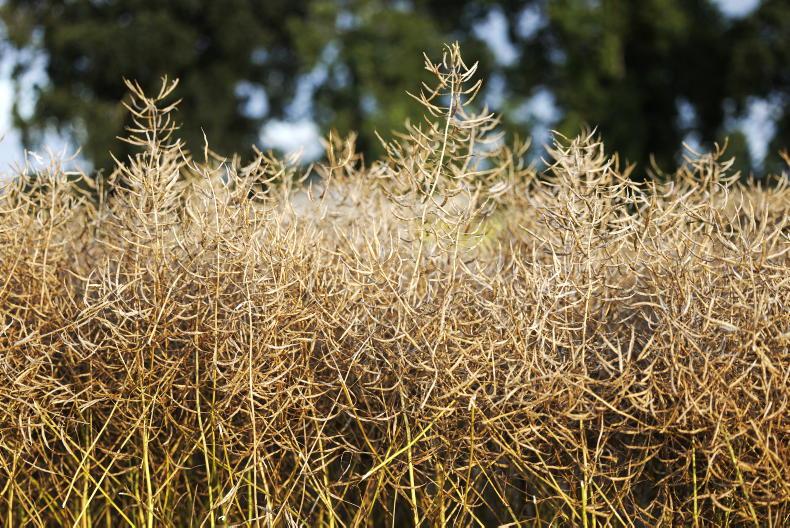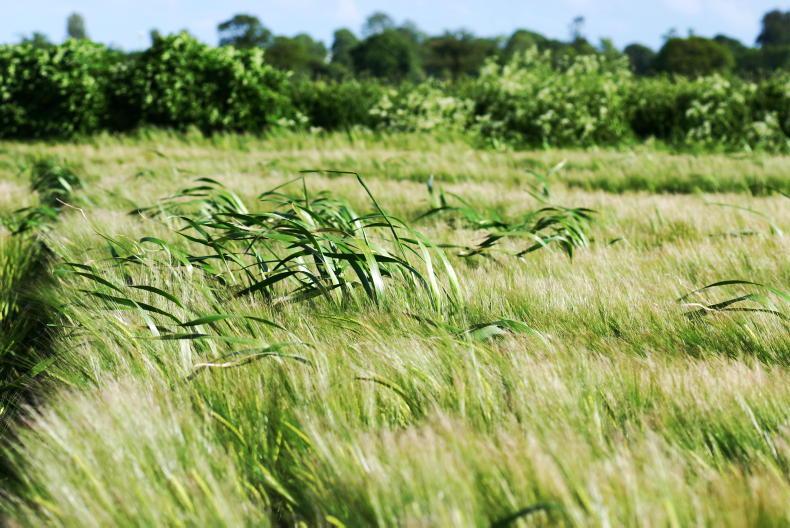
Julian harvesting the last of his spring barley in the Wexford sunshine.
Ballycarney, Co Wexford
Harvest weather over the past month has been ideal in Ballycarney. Harvest days have been long, typically ranging at 10.30am to 7.30pm, dews have been light and there was plenty of sunshine.
The spring barley harvest began on 4 August and finished 20 days later, one of the earliest harvests Julian can recall. This year’s harvest can only be described as easygoing and stress-free. “The harvest weather has been fantastic, it got a bit showery towards the end but really it has been easy on man and machine,” Julian remarks.
The growing season for Julian’s spring barley spanned just three months and two weeks. “It’s amazing the way crops caught up after being sown so late”.
Julian knew what to expect before the harvest began as his crops had been under significant moisture stress all year. In previous From the tramlines reports, he explained how some of his crops on his driest ground got badly burnt and he anticipated that screenings would be a problem.
Unsurprisingly screenings were high, as were protein levels. Yields ranged from under 2.0t/ac up to 2.9t/ac on cooler ground. Specific weights however were good, ranging from 60-69KPH with averages around 65KPH. Moistures were also low, ranging from 12-17% with averages closer 15.5%.
Soil husbandry pays off
Rotation and soil management made a significant difference this year as crops following beans or those grown on ground which had received an application of farmyard manure yielded close to 3.0t/ac. His Gangway seed crop performed the best out of all varieties with specific weights of 69KPH and yields of 2.7t/ac. Straw yields varied, ranging from four to eight 4x4 round bales per acre. “Soil type and sowing date really dictated straw yields.”
The focus now shifts to cover crop establishment under GLAS and preparation for next year. Julian foresees a change in cropping strategy going forward. He plans to sow more winter cereals due in part to a notable change in weather patterns.
“The harvest went well but what we really needed is last year’s yields at this year’s prices.”

Eugene preparing spring stubble ground for a catch crop using a Lemken Smaragd cultivator.
Portlaoise, Co Laois
The harvest has been a relatively smooth affair in Portlaoise with little weather-related interruptions. Showers have returned over the past couple of weeks however, but have been largely localised with some areas missing them.
The spring crop harvest commenced on 4 August and was largely wrapped up in seven days although Eugene did have to wait for the latest-sown crops to ripen. His latest-sown barley was drilled on 7 May and yielded 2.1t/ac. This year’s spring barley harvest was one of the earliest on record, although in 1995 the spring harvest started around the same time.
Fine weather meant that this was not an issue for harvesting but yields did disappoint. Eugene’s malting barley averaged 2.35t/ac and his Olympus seed barley averaged 2.1t/ac at averages of 16% moisture. Grain quality however was good. His malting barley averaged between 65-67KPH with screenings of between 1.0-1.5%. All of his malting barley passed for malting thanks to the derogation. Protein came in at between 11.5-12%, with the lowest coming in at 10.1%.
Screenings were higher in the Olympus seed crop, at around 5%. Specific weights in the crop were around 65-66KPH with moistures around 16%.
Straw yields were back but still ranged from six to eight 4x4 bales per acre. “The straw yields surprised me, I didn’t think the crop would bale as well. Straw was left for 24 hours before baling.
Secondary growth in spring
oilseed
Eugene desiccated his spring oilseed rape with Reglone (2.5l/ha) last week. There appears to be some secondary growth in the crop which has never happened before. “After recent rain, the thinner crops seem to be putting out new branches,” explains Eugene.
Fields were cleared over the week which will allow for cover crops to be established on spring ground. Some spring ground will be sown with fodder rape while phacelia and vetch will be sown for his GLAS requirements.
The fodder rape will be fertilised. Fields are cultivated with a Lemken Smaragd before drilling with a one pass.
“The harvest has been straightforward and drama-free, there’s always an upside to a difficult year.”

John sowing leafy turnip and fodder rape at 8.6 kg/ha which he intends to graze during winter.
Ballinasloe, Co Galway
Broken weather over the past few weeks has halted harvest progress in Ballinasloe. Rainfall amounts have not been high, meaning ground conditions are good but drying days have been limited.
Since talking with John last, winter crop harvesting has been completed. Average winter barley yields finished at 4.0t/ac. Shortly after, he moved onto winter oats which were cut on contract. The crops averaged 3.3t/ac at 15% moisture content and quality was excellent. John didn’t cut any winter wheat as there wasn’t much sown but reports from the area suggest average yields were around 4.0t/ac.
The spring harvest commenced three weeks ago and for the first time in John’s life, spring oats were cut before spring barley. Spring oat performance has been very good with average yields of 3.0t/ac at moistures of 15%. The crop was thick but short and, as a result, straw yields were back at around seven 4x4 bales/acre.
Staggered spring harvest
The spring barley harvest started straight after spring oats. Broken weather has staggered harvest progress. “It’s hard to get through work in broken weather, last week it took four attempts to cut a 28 acre field,” explains John.
Yields so far have been very good however. John hasn’t cut any barley under 3.0t/ac and other growers in the area are much the same. Yields so far are ranging from 3.0t/ac to 3.35t/ac, with better crops still to come. Quality is excellent and moistures are ranging from 16-18%. Straw yields are back and straw breakdown is becoming a problem in some crops, particularly Irina.
All grain is treated with propionic acid before storing with application rates dependant on the moisture content. For example, grain between 16-18% receives 7.0l/t while grain over 20% receives 10l/t.
Once fields are cleared, the focus shifts to establishing fodder crops. John has been growing fodder crops after cereals for years and establishes them using a variety of methods including ploughing, tilling and sowing. Last week he sowed leafy turnip and fodder rape at 8.6 kg/ha.
“All it would take is for a number of fine days together at this time of year as we have the combine capacity to cover 50-55ac/day.”
Read more
Tillage management: time to get winter oilseed rape planted
From the tramlines: harvest moving well but rain returns in places

Julian harvesting the last of his spring barley in the Wexford sunshine.
Ballycarney, Co Wexford
Harvest weather over the past month has been ideal in Ballycarney. Harvest days have been long, typically ranging at 10.30am to 7.30pm, dews have been light and there was plenty of sunshine.
The spring barley harvest began on 4 August and finished 20 days later, one of the earliest harvests Julian can recall. This year’s harvest can only be described as easygoing and stress-free. “The harvest weather has been fantastic, it got a bit showery towards the end but really it has been easy on man and machine,” Julian remarks.
The growing season for Julian’s spring barley spanned just three months and two weeks. “It’s amazing the way crops caught up after being sown so late”.
Julian knew what to expect before the harvest began as his crops had been under significant moisture stress all year. In previous From the tramlines reports, he explained how some of his crops on his driest ground got badly burnt and he anticipated that screenings would be a problem.
Unsurprisingly screenings were high, as were protein levels. Yields ranged from under 2.0t/ac up to 2.9t/ac on cooler ground. Specific weights however were good, ranging from 60-69KPH with averages around 65KPH. Moistures were also low, ranging from 12-17% with averages closer 15.5%.
Soil husbandry pays off
Rotation and soil management made a significant difference this year as crops following beans or those grown on ground which had received an application of farmyard manure yielded close to 3.0t/ac. His Gangway seed crop performed the best out of all varieties with specific weights of 69KPH and yields of 2.7t/ac. Straw yields varied, ranging from four to eight 4x4 round bales per acre. “Soil type and sowing date really dictated straw yields.”
The focus now shifts to cover crop establishment under GLAS and preparation for next year. Julian foresees a change in cropping strategy going forward. He plans to sow more winter cereals due in part to a notable change in weather patterns.
“The harvest went well but what we really needed is last year’s yields at this year’s prices.”

Eugene preparing spring stubble ground for a catch crop using a Lemken Smaragd cultivator.
Portlaoise, Co Laois
The harvest has been a relatively smooth affair in Portlaoise with little weather-related interruptions. Showers have returned over the past couple of weeks however, but have been largely localised with some areas missing them.
The spring crop harvest commenced on 4 August and was largely wrapped up in seven days although Eugene did have to wait for the latest-sown crops to ripen. His latest-sown barley was drilled on 7 May and yielded 2.1t/ac. This year’s spring barley harvest was one of the earliest on record, although in 1995 the spring harvest started around the same time.
Fine weather meant that this was not an issue for harvesting but yields did disappoint. Eugene’s malting barley averaged 2.35t/ac and his Olympus seed barley averaged 2.1t/ac at averages of 16% moisture. Grain quality however was good. His malting barley averaged between 65-67KPH with screenings of between 1.0-1.5%. All of his malting barley passed for malting thanks to the derogation. Protein came in at between 11.5-12%, with the lowest coming in at 10.1%.
Screenings were higher in the Olympus seed crop, at around 5%. Specific weights in the crop were around 65-66KPH with moistures around 16%.
Straw yields were back but still ranged from six to eight 4x4 bales per acre. “The straw yields surprised me, I didn’t think the crop would bale as well. Straw was left for 24 hours before baling.
Secondary growth in spring
oilseed
Eugene desiccated his spring oilseed rape with Reglone (2.5l/ha) last week. There appears to be some secondary growth in the crop which has never happened before. “After recent rain, the thinner crops seem to be putting out new branches,” explains Eugene.
Fields were cleared over the week which will allow for cover crops to be established on spring ground. Some spring ground will be sown with fodder rape while phacelia and vetch will be sown for his GLAS requirements.
The fodder rape will be fertilised. Fields are cultivated with a Lemken Smaragd before drilling with a one pass.
“The harvest has been straightforward and drama-free, there’s always an upside to a difficult year.”

John sowing leafy turnip and fodder rape at 8.6 kg/ha which he intends to graze during winter.
Ballinasloe, Co Galway
Broken weather over the past few weeks has halted harvest progress in Ballinasloe. Rainfall amounts have not been high, meaning ground conditions are good but drying days have been limited.
Since talking with John last, winter crop harvesting has been completed. Average winter barley yields finished at 4.0t/ac. Shortly after, he moved onto winter oats which were cut on contract. The crops averaged 3.3t/ac at 15% moisture content and quality was excellent. John didn’t cut any winter wheat as there wasn’t much sown but reports from the area suggest average yields were around 4.0t/ac.
The spring harvest commenced three weeks ago and for the first time in John’s life, spring oats were cut before spring barley. Spring oat performance has been very good with average yields of 3.0t/ac at moistures of 15%. The crop was thick but short and, as a result, straw yields were back at around seven 4x4 bales/acre.
Staggered spring harvest
The spring barley harvest started straight after spring oats. Broken weather has staggered harvest progress. “It’s hard to get through work in broken weather, last week it took four attempts to cut a 28 acre field,” explains John.
Yields so far have been very good however. John hasn’t cut any barley under 3.0t/ac and other growers in the area are much the same. Yields so far are ranging from 3.0t/ac to 3.35t/ac, with better crops still to come. Quality is excellent and moistures are ranging from 16-18%. Straw yields are back and straw breakdown is becoming a problem in some crops, particularly Irina.
All grain is treated with propionic acid before storing with application rates dependant on the moisture content. For example, grain between 16-18% receives 7.0l/t while grain over 20% receives 10l/t.
Once fields are cleared, the focus shifts to establishing fodder crops. John has been growing fodder crops after cereals for years and establishes them using a variety of methods including ploughing, tilling and sowing. Last week he sowed leafy turnip and fodder rape at 8.6 kg/ha.
“All it would take is for a number of fine days together at this time of year as we have the combine capacity to cover 50-55ac/day.”
Read more
Tillage management: time to get winter oilseed rape planted
From the tramlines: harvest moving well but rain returns in places













SHARING OPTIONS